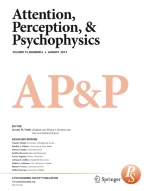3494Accesses
Abstract
Three visual search experiments tested whether top-down selectivity toward particular stimulus dimensions is possible during preattentive parallel search. Subjects viewed multielement displays in which two salient items, each unique in a different dimension—that is, color and intensity (Experiment 1) or color and form (Experiments 2 and 3)—were simultaneously present. One of the dimensions defined the target; the other dimension served as distractor. The results indicate that when search is performed in parallel, top-down selectivity is not possible. These findings suggest that preattentive parallel search is strongly automatic, because it satisfies both the load-insensitivity and the unintentionally criteria of automaticity.
Article PDF
Similar content being viewed by others
Avoid common mistakes on your manuscript.
References
Broadbent, D. E. (1958).Perception and communication. London: Pergamon.
Broadbent, D. E. (1982). Task combination and the selective intake of information.Acta Psychologica,50, 253–290.
Callaghan, T. C. (1984). Dimensional interaction of hue and brightness in preattentive field segregation.Perception & Psychophysics,36, 25–34.
Callaghan, T. C. (1989). Interference and dominance in texture segregation: Hue, geometric form, and line orientation.Perception & Psychophysics,46, 25–34.
Callaghan, T. C, Lasaga, M. I., &Garner, W. R. (1986). Visual texture segregation based on orientation and hue.Perception & Psychophysics,39, 32–38.
Cave, K. R., &Wolfe, J. M. (1990). Modeling the role of parallel processing in visual search.Cognitive Psychology,22, 225–271.
Duncan, J. (1980). The locus of interference in the perception of simultaneous stimuli.Psychological Review,87, 272–300.
Duncan, J. (1981). Directing attention in the visual field.Perception & Psychophysics,30, 90–93.
Ewksen, C. W., &Yeh, Y. Y. (1985). Allocation of attention in the visual field.Journal of Experimental Psychology: Human Perception & Performance,11, 583–597.
Folk, C. L., &Egeth, H. (1989). Does the identification of simple features require serial processing?Journal of Experimental Psychology: Human Perception & Performance,15, 97–110.
Garner, W. T., &Felfoldy, G. L. (1970). Integrality of stimulus dimensions in various types of information processing.Cognitive Psychology,1, 225–241.
Gottwald, R. L., &Garner, W. R. (1972). Effects of focusing strategy on speeded classification with grouping, filtering, and condensation tasks.Perception & Psychophysics,11, 179–182.
Jonides, J., Naveh-Benjamin, M., &Palmer, J. (1985). Assessing automaticity.Acta Psychologica,60, 157–171.
Jonides, J., &Yantis, S. (1988). Uniqueness of abrupt visual onset in capturing attention.Perception & Psychophysics,43, 346–354.
Kahneman, D., &Treisman, A. (1984). Changing views of attention and automaticity. In R. Parasuraman & D. R. Davies (Eds.).Varieties of attention (pp. 29–61). New York: Academic Press.
Neisser, U. (1967).Cognitive Psychology. New York: Appleton-Century-Crofts.
Neumann, O. (1984). Automatic Processing: A review of recent findings and a plea for an old theory. In W. Prinz & A. F. Sanders (Eds.),Cognition and motor processes (pp. 255–290). Berlin: Springer-Verlag.
Nissen, M. J. (1985). Accessing features and objects: Is location special? In M. I. Posner & O. S. M. Marin (Eds.).Attention and performance XI (pp. 205–219). Hillsdale, NJ: Erlbaum.
Pashler, H. (1988). Cross-dimensional interaction and texture segregation.Perception & Psychophysics,43, 307–318.
Posner, M. I., &Snyder, C. R. R. (1975). Attention and cognitive controls. In R. L. Solso (Ed.).Information processing and cognition: The Loyola symposium (pp. 55–85). Hillsdale, NJ: Erlbaum.
Quinlan, P. T., &Humphreys, G. W. (1987). Visual search for targets defined by combinations of color, shape, and size: An examination of the task constraints on feature and conjunction searches.Perception & Psychophysics,41, 455–472.
Shiffrin, R. M., &Schneider, W. (1977). Controlled and automatic human information processing. II: Perceptual learning, automatic attending and a general theory.Psychological Review,84, 127–190.
Theeuwes, J. (1989). Effects of location and form cuing on the allocation of attention in the visual field.Acta Psychologica,72, 177–192.
Theeuwes, J. (1990). Perceptual selectivity is task dependent: Evidence from selective search.Acta Psychologica,74, 81–99.
Theeuwes, J. (1991). Exogenous and endogenous control of attention: The effect of visual onsets and offsets.Perception Sc. Psychophysics,49, 83–90.
Treisman, A. M. (1982). Perceptual grouping and attention in visual search for features and for objects.Journal of Experimental Psychology: Human Perception & Performance,8, 194–214.
Treisman, A. M. (1988). Feature and objects: The fourteenth Bartlett memorial lecture.Quarterly Journal of Experimental Psychology,40, 201–237.
Treisman, A. M., &Gelade, G. (1980). A feature integration theory of attention.Cognitive Psychology,12, 97–136.
Treisman, A. M., &Gormican, S. (1988). Feature search in early vision: Evidence from search asymmetries.Psychological Review,95, 15–48.
Yantis, S., &Jonides, J. (1990). Abrupt visual onsets and selective attention: Voluntary versus automatic allocation.Journal of Experimental Psychology: Human Perception & Performance,16, 121–134.
Author information
Authors and Affiliations
TNO Institute for Perception, P.O. Box 23, 3769, Soesterberg, ZG, The Netherlands
Jan Theeuwes
- Jan Theeuwes
You can also search for this author inPubMed Google Scholar
Additional information
This study was supported in part by the Institute for Road Safety Research, SWOV. I thank L. C. Boer, O. Neumann, J. B. I. Riemersma, and A. F. Sanders for helpful comments on an earlier draft of the article.
Rights and permissions
About this article
Cite this article
Theeuwes, J. Cross-dimensional perceptual selectivity.Perception & Psychophysics50, 184–193 (1991). https://doi.org/10.3758/BF03212219
Received:
Accepted:
Issue Date:
Share this article
Anyone you share the following link with will be able to read this content:
Sorry, a shareable link is not currently available for this article.
Provided by the Springer Nature SharedIt content-sharing initiative



